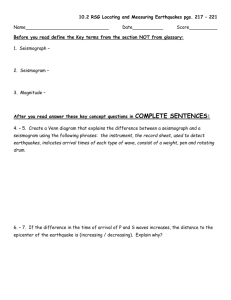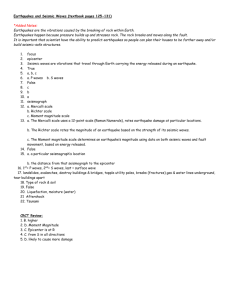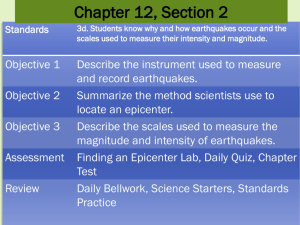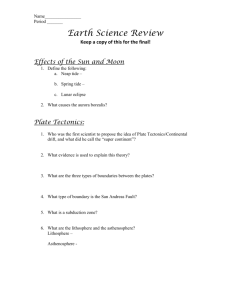10.2 - Cloudfront.net
advertisement
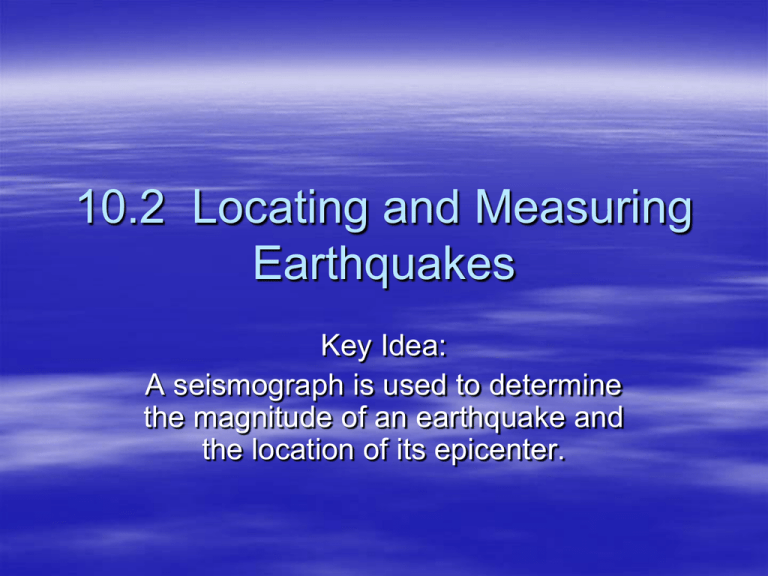
10.2 Locating and Measuring Earthquakes Key Idea: A seismograph is used to determine the magnitude of an earthquake and the location of its epicenter. What is Seismograph? A seismograph is an instrument that detects and records waves produced by earthquakes. Scientists use data from seismographs to locate the earthquakes’ epicenters , and measure their magnitudes. There are more than 10,000 seismic stations which monitor the seismic activity world wide. The Seismograph Fundamentally, a seismograph is a simple pendulum. When the ground shakes, the base and frame of the instrument move with it, but inertia keeps the pendulum bob in place. It will then appear to move relative to the shaking ground. As it moves it records the pendulum displacements as they change with time, tracing out a record called a seismogram. The basic seismograph, as described above Notice the parts: Base Pendulum Moving paper Types of Seismographs Because an earthquake produces different types of waves, there are seismographs which record each type of wave. Some record the side-to-side motion of the bedrock (created by P waves) Others record the up-and-down motion (created by the S waves). Horizontal Seismograph (records P waves) Vertical Seismograph This types records the up-and-down movements (S waves) How is an Earthquake’s Epicenter Located? Time-distance graph showing the average travel times for P- and Swaves. The farther away a seismograph is from the focus of an earthquake, the longer the interval between the arrivals of the P- and S- waves Locating the Epicenter Let’s imagine that a seismic station located in city A records an earthquake that took place “a” miles away. This earthquake could be anywhere around City A, on a circle with a radius of “a” miles. Two other stations, in cities B and C record the same earthquake, at distances “b” and “c” respectively. To locate the epicenter, the scientists draw circles centered at each seismic station, with radii of “a”, “b”, and “c”. The point where they intersect, is the epicenter of the earthquake. How is an Earthquake’s Epicenter Located? Three seismograph stations are needed to locate the epicenter of an earthquake A circle where the radius equals the distance to the epicenter is drawn The intersection of the circles locates the epicenter The Magnitude of an Earthquake The magnitude is the amount of energy released during an earthquake. The RICHTER scale of magnitude is one widely used to measure the magnitude of earthquakes. It was developed by Charles Richter of the California Institute of Technology. The Richter Scale The Richter scale is used to measure the magnitude of earthquakes. The scale, more formally known as the Richter magnitude test scale, ranges from 0 to over 8.0. It is a logarithmic scale, meaning each unit increase on the scale corresponds to an absolute increase by an order of magnitude, or factor of 10. Earthquakes less than about 2 on the Richter scale are meaningless as they can barely even be measured, much less felt. An earthquake is not really newsworthy until it hits about 5. At magnitudes of 7.0 or 8.0 the damage can be catastrophic.


